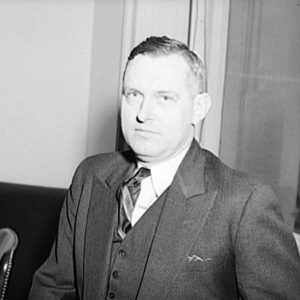calsfoundation@cals.org
John Roy Steelman (1900–1999)
John Roy Steelman, the son of lower-middle-class cotton farmers, rose to become one of President Harry S. Truman’s best friends and top advisors. He performed valuable government services, sometimes without official title, during the administrations of Presidents Franklin D. Roosevelt, Truman, and Dwight D. Eisenhower.
Born on June 23, 1900, on a farm near Thornton (Calhoun County) to Pleasant (Ples) Cydney Steelman and Martha Ann Richardson Steelman, John Roy Steelman was the oldest child in a family of six boys and one girl. He finished high school and, through the Department of War’s Student Army Corps established during World War I, was able to attend Henderson-Brown College in Arkadelphia (Clark County). After discharge from the army, he managed to stay in college by working at any job he could get, including logging and sawmill work, laboring in the wheat fields of Kansas, selling books and insurance, serving as a dock worker on the Gulf Coast, waiting tables, and pressing pants for his fellow students, as well as grading papers for professors. After graduation from Henderson-Brown in 1922 with a BA degree, he attended Vanderbilt University where, on the advice of his counselor, he earned a bachelor’s and master’s degree in theology in 1924. He entered Harvard University and then transferred to the University of North Carolina, where he received a PhD in sociology and economics in 1928.
After receiving his doctorate, Steelman taught sociology at Alabama College in Montevallo, Alabama, for six years. Frances Perkins, Franklin Roosevelt’s secretary of labor, met Steelman when she delivered a commencement address there and was impressed with his recent settlement of a labor dispute in Mobile, Alabama. She persuaded him to go to Washington DC to work for the U.S. government’s Conciliation Service. After three years, he became director of the service. During his tenure, he transformed the service from an emergency-driven operation to one that prevented strife. Cases referred to the agency increased more than twenty fold, and over ninety percent were settled without their having to be referred to arbitration by the National Defense Mediation Board.
Steelman remained in the Conciliation Service until after Roosevelt’s election in 1944 for a fourth term. He then went to New York to work as a public relations consultant, working with large corporations, advising them on their public image and trying to get labor leaders and employees to try to understand each other better.
When President Harry Truman assumed office following the death of President Roosevelt in 1945, he appealed to Steelman to return to Washington for six months to serve as an advisor to the secretary of labor. In that position, he helped to smooth the transition in the dissolution of wartime programs and settle differences between various government agencies. Steelman became director of the Office of War Mobilization and Reconversion and director of economic stabilization. At the end of the postwar programs, he refused an offered position as undersecretary of labor, preferring to work at the White House. In December 1946, Truman appointed him assistant to the president and, in that capacity, he sat in on all cabinet meetings as the only non-secretary attending.
Steelman’s disposition made him a great troubleshooter and mediator. He was a patient and tenacious hard worker, willing to take on any necessary task, and he felt that, if reasonable people sat down together to discuss differences rationally, they could come to a logical and peaceful solution. He was reportedly easy to talk to, and he attempted to stay neutral in negotiations. Among outstanding negotiations he mediated were the steel strikes of 1946, the coal strike of 1948–49, the rail strike of 1948, and the particularly contentious steel seizure and strike of 1952. The six-month engagement that he originally agreed to became a seven-year stint, and he remained in an advisory position over the transition into office of newly elected President Eisenhower.
After leaving government service, he served as president of the Montgomery Publishing Company, chairman of the board of the Record Publishing Company, and publisher of newspapers in Bethesda, Silver Spring, and Rockville, Maryland. He retired in 1969.
Steelman had married Emma Zimmerman of St. Louis, Missouri, a secretary for the Building and Trades Council, on October 7, 1939. They had an adopted daughter. His first wife predeceased him, and he married Ellen Brown Hart in July 1965.
Steelman died on July 14, 1999, in Naples, Florida, where he had lived after his retirement.
For additional information:
John R. Steelman Papers. Harry S. Truman Library and Museum, Independence, Missouri.
Ravo, Nick. “Arkansan Hoboed, Earned Doctorate, Aided Truman.” Arkansas Democrat-Gazette, July 23, 1999, p. 2B.
Wagnon, William O., Jr. “John Roy Steelman: Native Son to Presidential Advisor.” Arkansas Historical Quarterly 27 (Autumn 1968): 205–225
Katherine Stanick
Little Rock, Arkansas
 John Steelman
John Steelman 




Comments
No comments on this entry yet.